WRITTEN BY
Jay Tindall
PUBLISHED ON
Feb 14, 2013
LOCATION
India
Imagine a festival in which every American, from Denver to the Pacific, from Seattle to Phoenix and from Cheyenne to San Diego was in attendance – between 80 and 100 million living souls. India’s Maha Kumbh Mela is such a festival.
The largest peaceful gathering on Earth, the Kumbh Mela festival involves millions of people making a pilgrimage to the confluence of the Ganges and Yamuna rivers, where they will bathe in an attempt to purify their sins. The festival takes place where the Hindu scriptures say the gods spilt a single drop of the elixir of eternal life. Kumbh means “pitcher,” a reference to the orb from which the elixir was dropped during the great “churning of the ocean.”.”) The term “Mela” means “fair.” Vishnu is said to have spilled four drops of the elixir: one in Nashik, Ujjain, Haridwar and Allahabad/Prayag. Hence, there are four distinct Kumbh Mela celebrations in these spots.
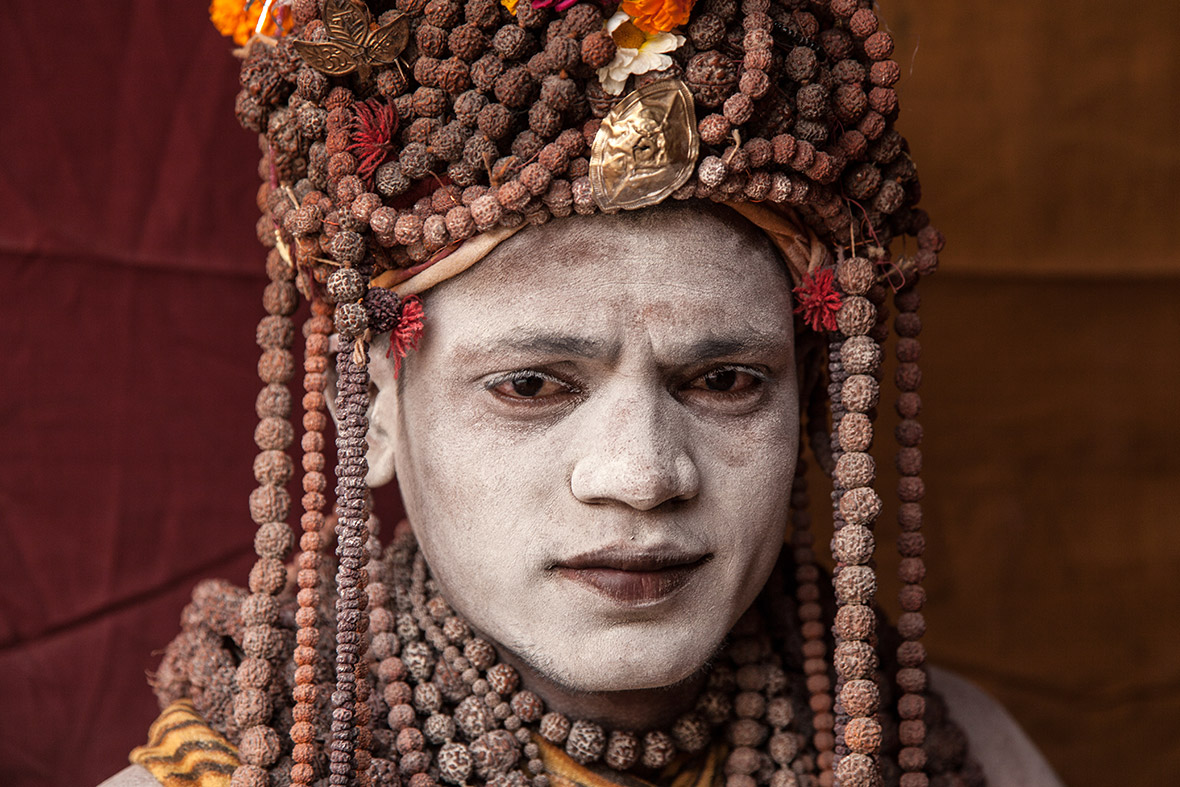
ABOVE: A Naga Baba, naked except for the beads he was wearing.
The festival lasts for more than a month. The first written account of this event comes from the Chinese traveler Huan Tsang, who attended the festival in 629 A.D., thoughHindus will tell you the festival is much older than that. In 1892, a cholera outbreak at the Kumbh Mela caused British authorities to contemplate better sanitation and organization methods for the event, which is also no stranger to fatalities.

ABOVE: Hindu pilgrims head to the Kumbh Mela
Attending such an event comes with a price. There is danger to be sure. The New York Times reports that scores of people were trampled to death at the 2013 event. The challenges of navigating such an event as a travel professional, writer and photographer are daunting to say the least. Yet my hunger and thirst for adventure, for the exotic and the unknown, pulled me to India like a latter-day Rudyard Kipling.
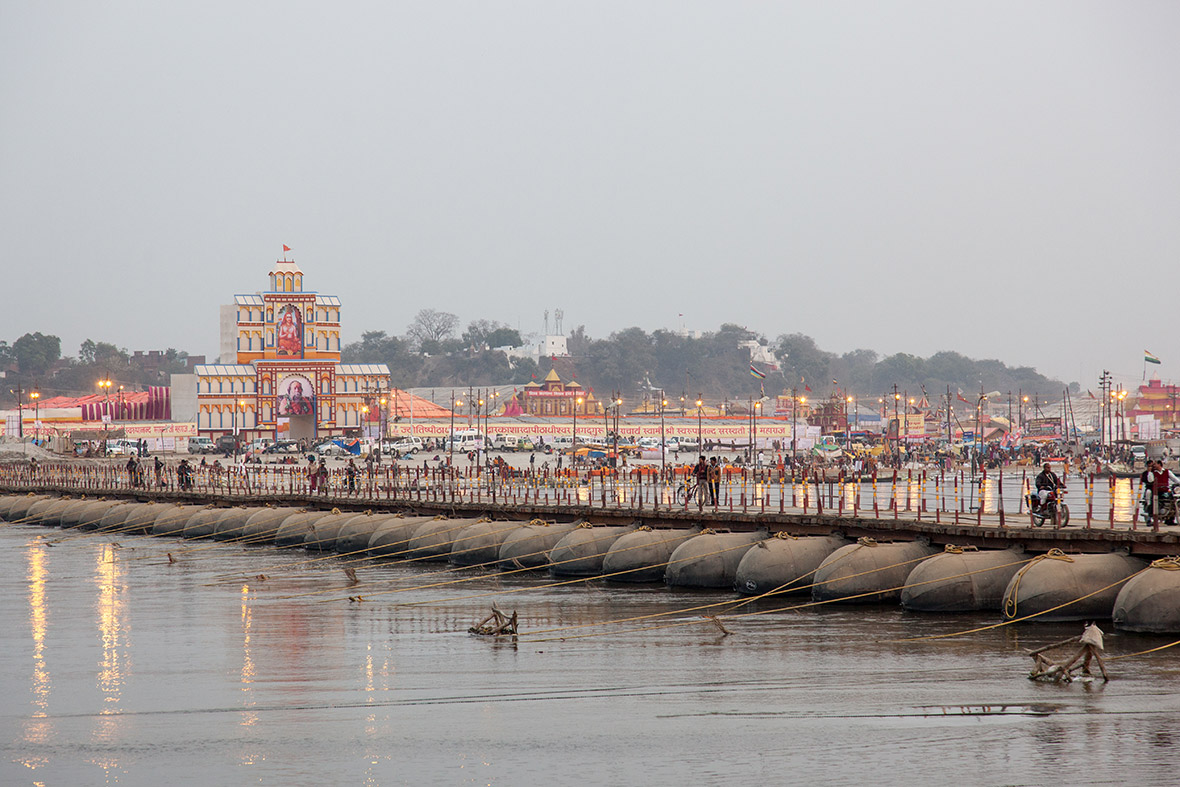
ABOVE: One of many temporary bridges leading to the Kumbh Mela grounds.
I flew to India from Bangkok, excited and apprehensive at the same time for the events to follow. After two days in Varanasi, I drove 3.5 hours to Allabhad, where the Kumbh Mela was due to take place. This part of the festival occurs at the Sangam (the confluence of three mystical rivers) every 12 years. Some of those in attendance are cave-dwellers who only emerge from their respective dwellings for the festival. This is the type of ancillary detail that makes so much of everything else seem irrelevant.
Within a few minutes of checking into the Lakshmi Kutir tented camp and grabbing a bite of lunch, I ran into Diego Buñuel, host of one of my favorite travel shows, “Don’t Tell My Mother.” I always enjoy his show because in many ways, I travel like Diego. I like edgy places such as Haiti, Nigeria, Lebanon, Colombia and North Korea. Chatting with Diego while he shot a documentary made me feel I was in the right place, and and this feeling would be proved over the next two days.

ABOVE: A Naga Baba Sadu.
On the first day, we headed into the Kumbh to get a sense of what was going on. It required a walk of several kilometers in each direction, and it was here that we were truly able to take in the true immensity of the festival. The Kumbh grounds are an impromptu city that’s so large it can be seen from outer space.
Coming from Varanasi, a fairly dirty Indian city, I expected the worst at the Kumbh — however I was pleasantly surprised. The organization was impressive. There wasn’t trash strewn all over the place (as I would see in other Indian cities) and it didn’t have that familiar pungent smell for which India is famous. This was unusual to say the least, considering I’d often witness people defecating in the middle of a field in plain sight. The tented city was laid out in a comprehensive grid system, with dedicated medical, police and administration for each area.

ABOVE: Two friendly Naga Baba Sadu’s that we spent time talking to.
Although the grounds were huge, we knew where we were headed — to the Akharas, where the Naga Babas meditate and perform rituals. These are the most interesting and radical of Hindus — giving up all possessions including their clothes, smoking hash, covering their bodies with ash and various other facets, and making their homes in forests and remote caves. The history of the Naga Baba (the word “Naga” comes from “nagna” meaning “naked, and the term “Baba” means “father” or “uncle” in Sanskrit) is as wonderful as it is unique. They wear special beads of Rudraksha, believed by Hindu mythology to possess healing powers. It is believed that wearing 11,000 beads will help them attain the form of Lord Shiva. Smoking “chillum,” or marijuana, is believed to be another path towards nirvana.

ABOVE: Our favorite Naga Baba, who had a mobile phone and business cards, but wore no clothes.
Our guide knew several of the Naga Babas so I sat down with a group of them for blessings. Ashes were placed on my head, and I was handed holy food to eat, tasted like dirt with pieces of sugar in it. The four Naga Babas we met were friendly and regaled us with details about their religion and the festival. They were naked, apart from watches, rings, and mobile phones, and even business cards, and were smoking enormous quantities of hash. As they talked, we listened, taking photos and absorbing our surroundings. We visited with several others before making the long walk back to the Lakshmi Kutir camp.
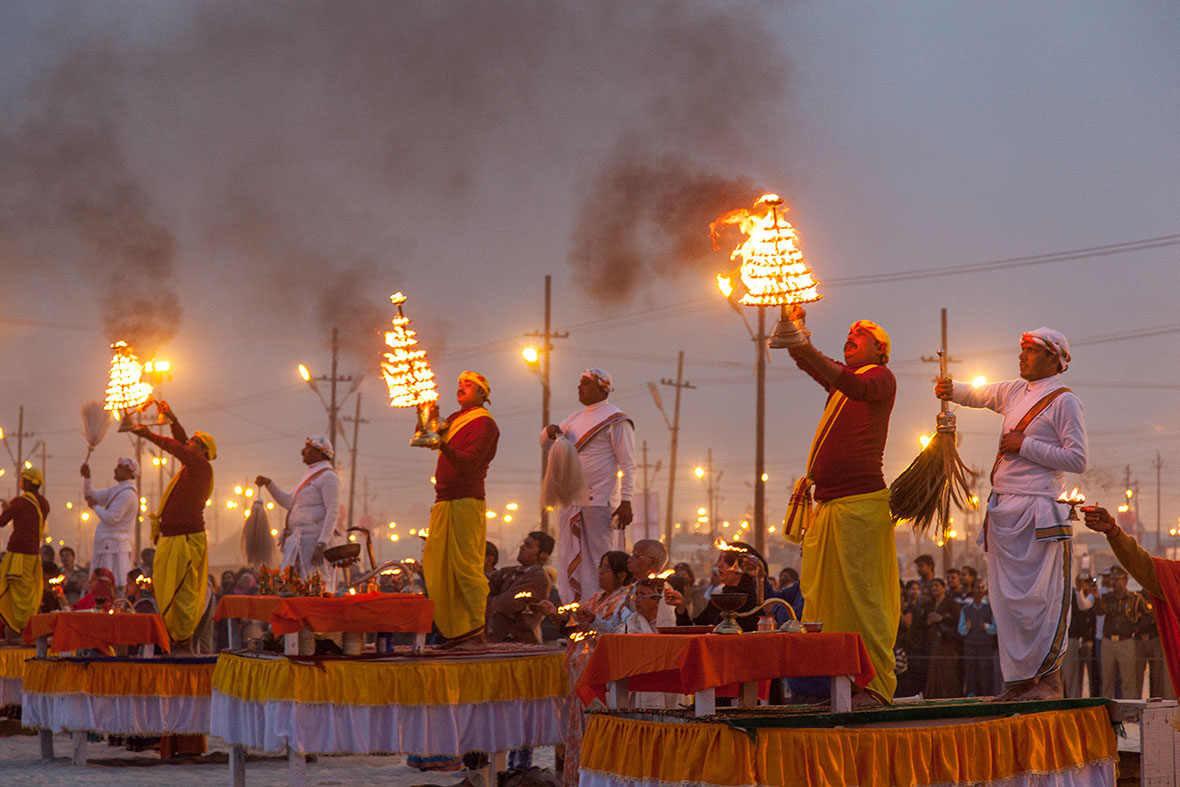
ABOVE: Evening Aarti ceremony
We stopped at an evening Aarti ceremony and were welcomed to attend. Aarti descends from the Vedic concept of fire rituals and refers to a Hindu religious rite in which a part of a puja, which unfolds with “light” from wicks bathed in purified butter, is offered to several Hindu deities.. While the rituals unfolded, songs were sung to deities, and the strong, sweet smell of incense permeated the air, burned to demonstrate a purified state of mind. One’s own level of intelligence is measured at the ceremony by one’s adherence to the ritual processes. In the ritual, the performer faces God or a form of God (the Ganges, for example) and the light or flame represents the deity’s spirit. The Aarti is moved around in a clockwise fashion to demonstrate our daily activities, symbolizing the belief that God is at the very center of our lives.
The next day we left the camp at the break of dawn to walk down to the Sangem, in our quest to photograph pilgrims taking a holy dip at the confluence of the three rivers.

ABOVE: Pilgrims taking a predawn dip at the Sangem.
After arriving at the river, I separated from the others and hired a boat to take me to one of the islands at the center of the river, where many people were bathing. There were no other foreigners here. It was still completely dark and the boatman had some trouble negotiating the currents.

ABOVE: Taking a boat to the Sangem in the predawn hours.
We observed and photographed people immersing themselves in the freezing pre-dawn water. People were praying, yet they were also playing as well. This was family time and the ritual held deep spiritual importance for them. Various elements of the spiritual experience: the personal and the familial, were simultaneously co-existing in the same moment.
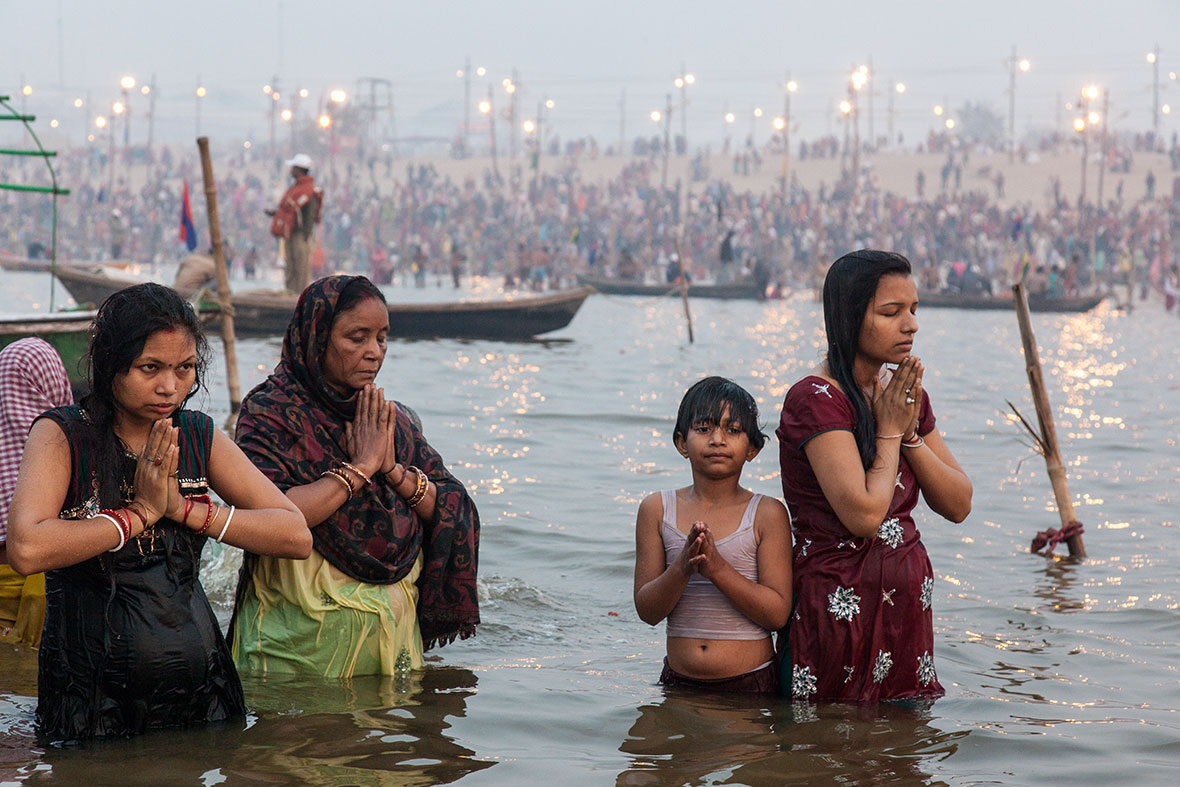
ABOVE: Thousands were bathing in the Sangem, praying and having fun too.
After an hour or so, we headed back to our starting point and made our way by foot into the main Kumbh grounds. This was one of the festival’s most significant days, and as such, I noticed a huge influx of people had poured in overnight.

ABOVE: We observed a group of “Jangams” singing for the Naga Babas.
We met a Naga Baba who had held one hand in the air for ten years. Another had stood on one leg for ten years and was planning to stand normally again after three more years. We encountered another who picked up a large bundle of heavy bricks with his penis. This was unlike any place I had ever been, a place where the customs of western society were completely alien. We observed a group of “Jangams” singing for the Naga Babas. The Jangams are a mystical caste of nomads attached in a tangential line. Their trance-like state while singing is said to produce secret knowledge.
In the distance, we could see that there was something strange going on. There was a group of around 100 people on the horizon. We headed over as quickly as we could, to discover a large group of men undergoing an initiation ceremony to become Naga Babas. Sporting freshly-shaven heads, they had given up all of their possessions apart from a loincloth.. Suddenly, they dashed into the Ganges to place offerings into the river.
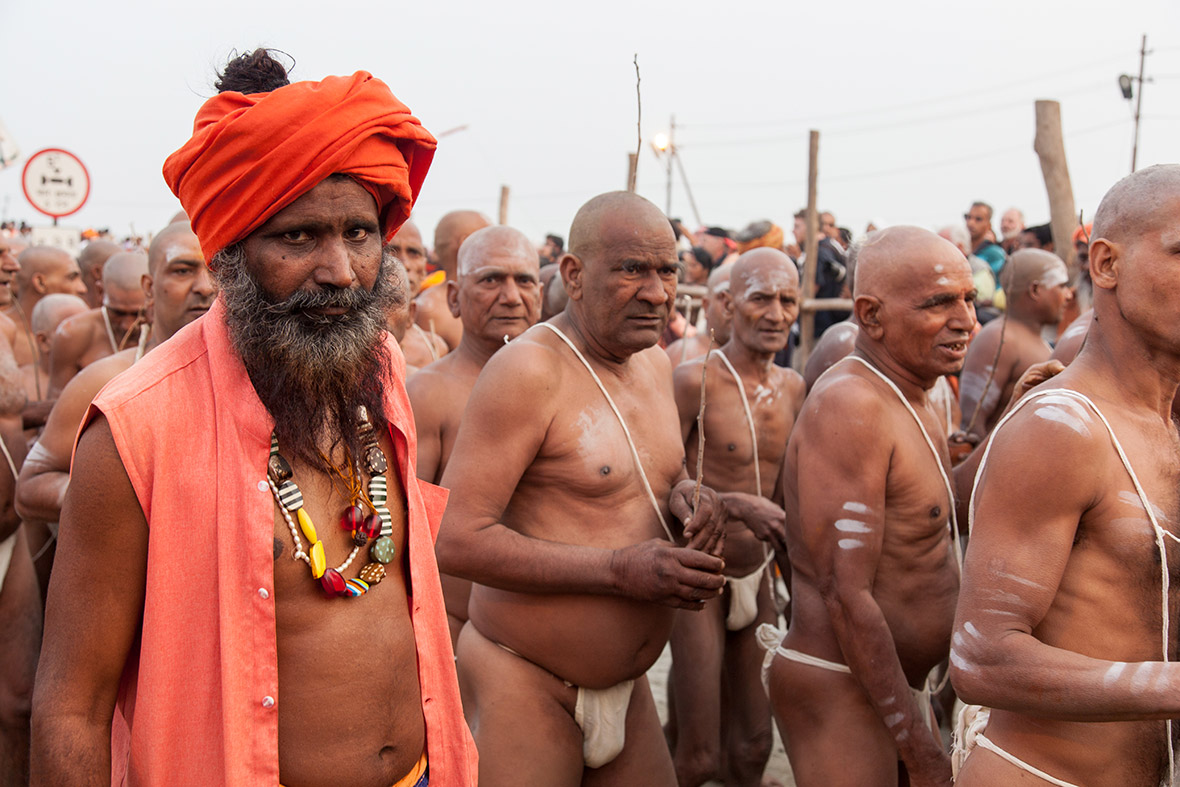
ABOVE: The Naga Baba initiates were elated to begin their new lives.
They were then corralled together by the senior members wielding big sticks and forced to sit on the ground for an hour. We knew something was going to happen, so we waited patiently. It was nearly impossible for anyone to get close to the group — we saw a few attempts by eager photographers, but they were beaten back by the men with sticks -Indian crowd control at its finest. We could see that these Naga initiates would all exit through a narrow space leading to the main road, so we made our way there and waited. The men with sticks scowled at us, but we stood our ground. Sure enough, when the procession began, we were in a prime spot. The new Naga Babas of all ages and backgrounds stood hand in hand, elated to begin their new lives.

ABOVE: The Naga initiates were closely guarded by senior members wielding big sticks.
Their initiation rituals are top secret and they never divulge exactly what transpires. “Diksha,” is an initiation rite orchestrated by gurus. When they pass through the ritual, they can become “Naga Sadhus” or “holy men”. Such holy men leave the world behind to live in caves and temples throughout India and Nepal. Five million of them live such a life in India today. Interestingly, in 2013, the women of this holy order have won the battle to have their own private women’s camp. They are an order of nuns called the Juna Sannyasini Akhara.
In Sanskrit, “sadhu” means “good man.” This references their lives lived on the outer fringes of society, without being governed by India’s repressive traditional caste system. “Sadh” in turn comes from Sanskrit, meaning “make straight,” “gain power over” and “reach one’s goal.” It is similar to “Sadhana,” a term that infers “spiritual practice.” Sadhus are sometimes feared for their ability to project curses on others. These curses are deemed powerful and difficult to reverse. As such, the Sadhus are both hailed and feared at the same time.

ABOVE: The naked or “sky-clad” have dreadlocks and don’t shave.
While they are venerated in some parts of India (mostly rural), in urban areas they are looked upon with suspicion. Beggars who are not devout followers of this path have been known to pose as Sadhus in order to gain material rewards — money or food. There are various strains of Sadhus. The naked or “sky-clad” have dreadlocks and don’t shave. Then there are the sword-carrying Jata. Beyond that are the Aghora Sadhus, who are believed to commune with ghosts and live in cemeteries. Just as Indians believe there are many paths to God, the variety of Sadhu offshoots and branches reflects that notion.
The Naga Babas are a unique, and almost priestly caste, greatly admired by most of Indian society. Their ascetic ways are deemed to purify sins and can transform the karma of entire communities. This is a truly ancient religion.

ABOVE: Naga initiates huddled around campfires.
We headed back to our friendly Naga Baba compound and discovered all the new Nagas there as well, bundled around campfires for the long night of ceremonies. We snapped more photos, and headed back towards our camp by rickshaw.
Watching the sun dip beneath the horizon, I pondered all I had seen. The sun rises and sets on this Earth every day without ceasing. In the winter the birds fly south. The Moon controls the tides. The cycle continues, unending, having begun before time was even recorded. India is one of the oldest civilizations on Earth and I had managed to unlock one of her grandest secrets. It was the perfect ending to my Indian discovery.


